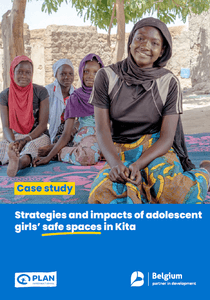Strategies and impacts of adolescent girls’ safe spaces in Kita
This report reviews the implementation of an adolescent girls' safe spaces programme in Kita, Mali and provides recommendations to support future interventions.

In 2021, Plan International implemented a project to strengthen the protection and empowerment of adolescent girls in the humanitarian context of Kita. This project included the creation of safe spaces for adolescent girls.
How the safe spaces were set up
A methodical and participatory approach was used to set up the programme, with a number of key stages to ensure that the specific needs of adolescent girls were effectively taken into account. The approach began with an in-depth analysis of the local context, gender norms and community dynamics, helping to identify the risks and opportunities associated with establishing safe spaces for adolescent girls. A security audit was also carried out to ensure the safety of the chosen spaces, followed by a mapping of available services to effectively refer adolescent girls to the necessary support.
The involvement of communities, including leaders, parents and the teenage girls themselves, was crucial in the planning and management of the activities. A predominantly female team was formed to manage the project, ensuring that services were tailored to the needs of the girls.
The activities offered were diverse, ranging from psychosocial support and reproductive health education to life and economic skills workshops, all designed to meet the specific needs of the girls and empower them. Regular monitoring and supervision of activities were put in place to assess the effectiveness of the programme and make any necessary adjustments.
Impact on adolescent girls
The safe spaces have made a significant contribution to the prevention and management of gender-based violence in Kita, providing a safe environment for adolescent girls to express themselves, learn and obtain psychosocial and legal support. They have enabled girls to better understand and manage the risks associated with gender-based violence, improving their well-being and strengthening their life skills.
Recommendations
- Carry out a gender analysis, risk and needs assessment and mapping of protection services before setting up safe spaces.
- Ensure the active and respectful participation of adolescent girls in the design and development of safe spaces.
- Set up an all-female AGSS management team.
- Optimise psychosocial support by offering a variety of activities adapted to the age and needs of participants.
- Using intergenerational dialogue as a key strategy for de-stigmatising and combating gender-based violence.
- Strengthening the impact and sustainability of safe spaces through the strategic involvement of community and religious leaders.
- Using safe spaces to identify cases of gender-based violence and refer survivors to services.
- Integrating safe spaces into an overall strategy for protecting children in emergency situations.
Download the report
English
2 mb
French
2 mb
Categories: Emergencies, Protection from violence
